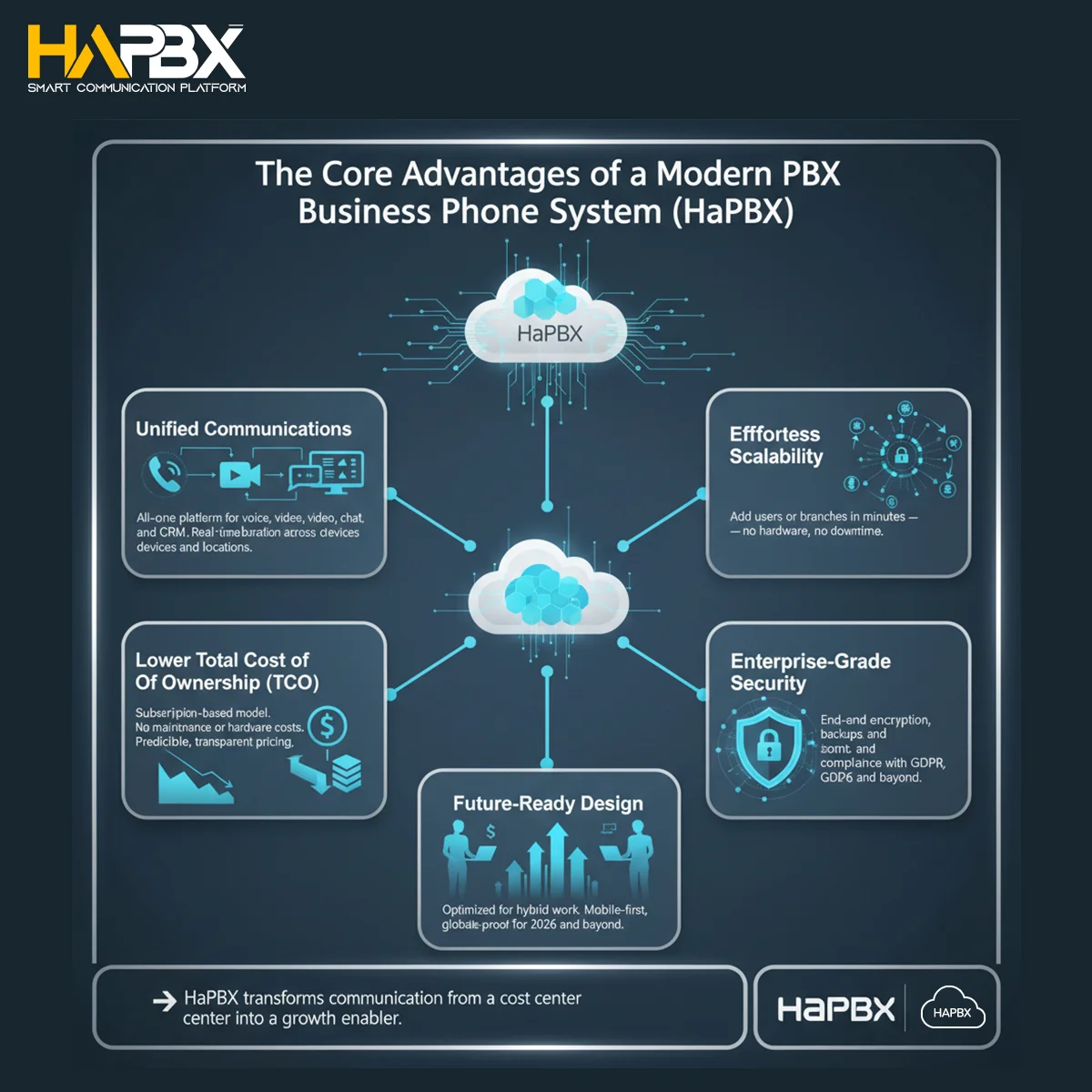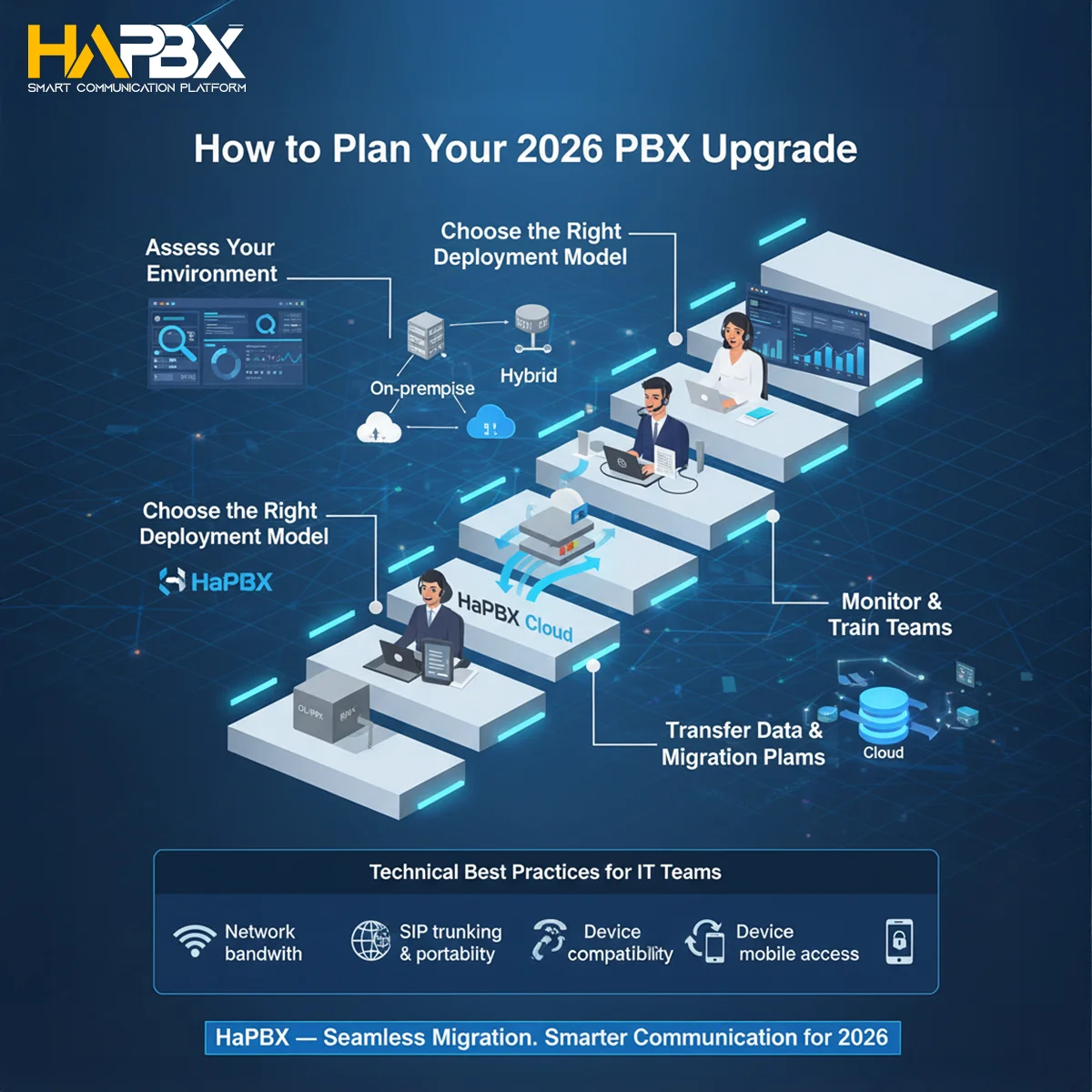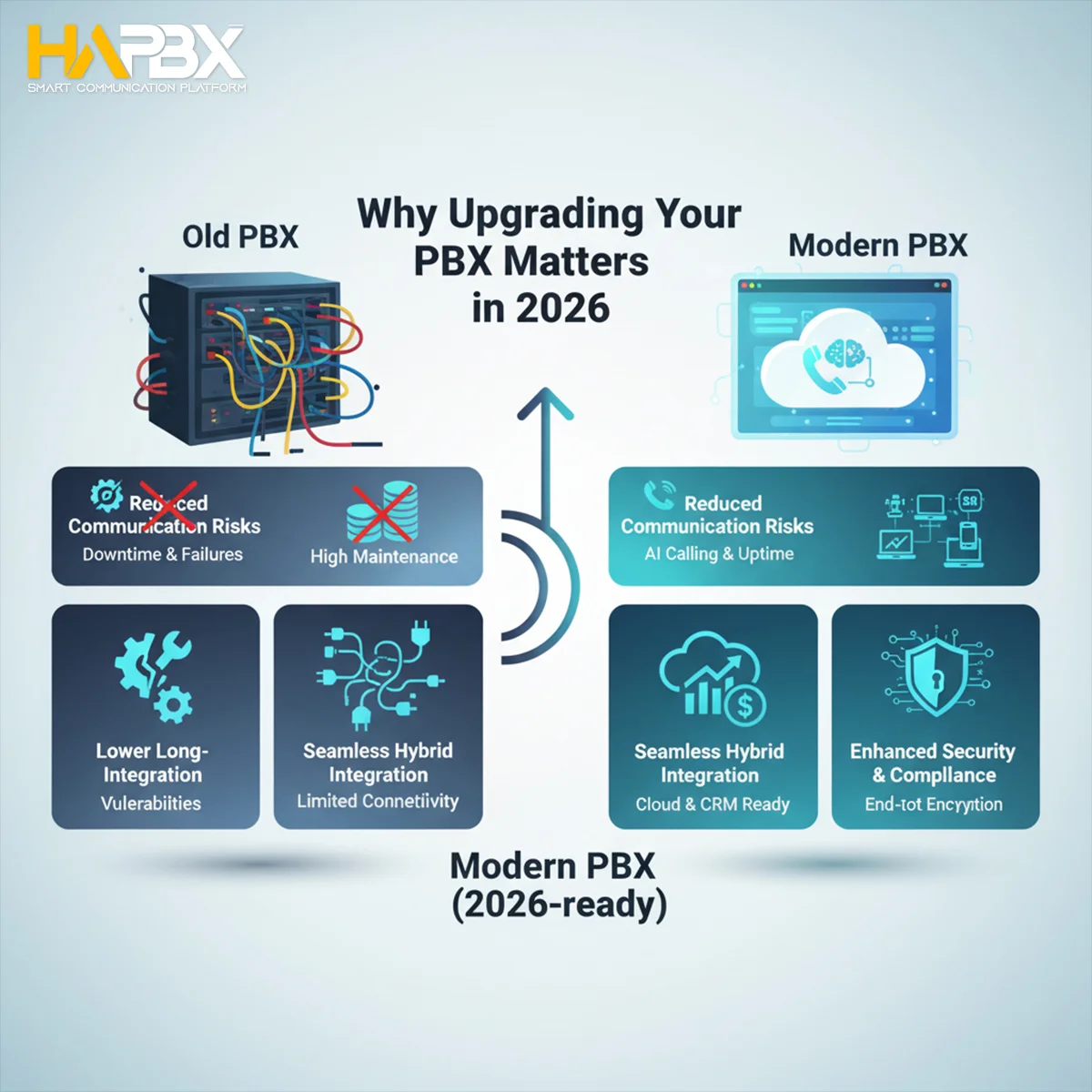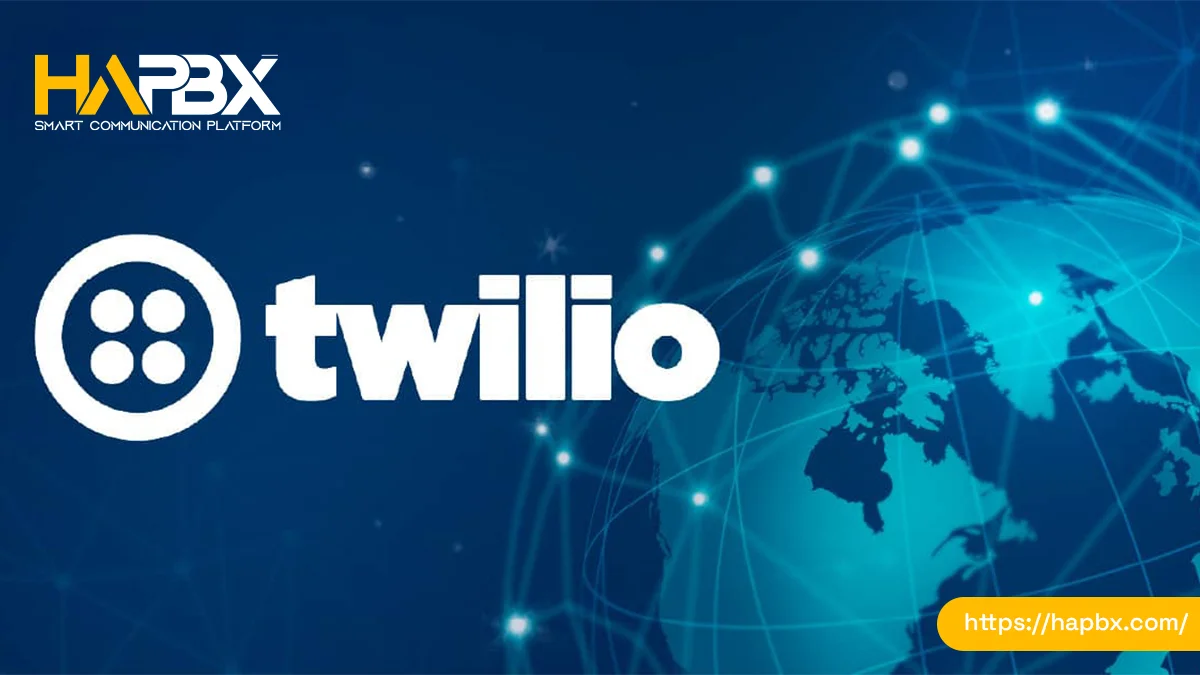“In today’s connected business landscape, holding onto outdated PBX systems is more than an inconvenience — it’s a growth barrier.”
If you still believe your legacy PBX “gets the job done,” 2026 will be the year that mindset costs you dearly. It’s time to upgrade PBX holding and align your communication stack with the future.
1. Why “Upgrade PBX Holding” Matters in 2026
Reduced Communication Risks
Legacy PBX systems are reaching the end of their support cycles. Firmware updates stop, parts become obsolete, and call quality deteriorates. The longer you hold your PBX, the more reliability issues you’ll face.
Escalating Costs & Hidden Inefficiencies
Aging hardware increases maintenance costs exponentially. Postponing an upgrade means you’re paying more to keep a dying system alive — a poor long-term investment.
Hybrid Work & App Integration
In 2026, mobility and integration are no longer optional. Teams need voice, video, chat, and CRM access within one platform. If your PBX can’t support unified communication, it’s holding your business back.
Security & Compliance Risks
Old PBX setups are easy targets for toll fraud, call interception, and denial-of-service attacks. Upgrading ensures data encryption, multi-layer authentication, and compliance with global standards.

2. Signs Your PBX System Is “Holding” You Back
Recognizing the warning signs early can save your organization from costly downtime and operational inefficiencies. If any of the following issues sound familiar, it’s time to upgrade PBX holding before your communication backbone becomes a liability.
Frequent Call Drops, Jitter, or Poor Audio Quality
Legacy PBX systems often struggle to maintain consistent call quality due to outdated hardware, limited bandwidth optimization, and aging cabling infrastructure.
When calls start dropping mid-conversation or audio becomes distorted with jitter and latency, it’s more than just a nuisance — it disrupts sales, damages customer trust, and reduces internal efficiency.
A modern PBX solution like HaPBX uses cloud routing, adaptive codecs, and QoS (Quality of Service) monitoring to ensure crystal-clear audio and uninterrupted connectivity — no matter how many concurrent users are online.
Limited Technical Support and Expensive Maintenance
Many traditional PBX vendors have phased out support for older systems, leaving IT teams with minimal help and rising costs.
Replacing parts for End-of-Life (EOL) models becomes an endless search through third-party suppliers, each component costing more than it’s worth.
Every service call to repair or reprogram your system adds unnecessary expenses, draining budgets that could otherwise fund modernization.
By upgrading PBX holding to a cloud-based platform like HaPBX, you eliminate these hidden maintenance costs — no physical servers, no hardware dependencies, and no waiting for vendor callbacks.
Missing 2026-Ready Features
The business communication environment in 2026 demands flexibility, mobility, and integration.
If your PBX doesn’t support video conferencing, softphones, call recording, or CRM integration, it’s already falling behind.
Your competitors are connecting customers via unified dashboards where chat, voice, and analytics merge seamlessly — while your team is still transferring calls manually.
HaPBX includes these features by default, empowering your workforce to collaborate across devices, departments, and locations in real time.
Scalability Challenges
Traditional PBX systems weren’t designed for fast growth or remote work.
Adding a new user, department, or branch often requires new physical lines, server reconfiguration, and on-site technician visits. This rigidity slows expansion and adds friction to onboarding new teams or remote staff.
Cloud-native solutions like HaPBX are built to scale.
You can add or remove users, assign extensions, or open a new branch in minutes — all from an intuitive web dashboard, with no downtime or extra cabling required.
End-of-Life Hardware and Discontinued Vendor Support
Perhaps the biggest red flag: your PBX hardware has reached End of Life.
Manufacturers stop providing firmware updates, security patches, or replacement components, leaving your system vulnerable to cyber threats and compliance violations.
When you continue holding onto EOL equipment, you’re effectively running unsupported, unsecured communications — a major risk in 2026’s compliance-driven IT environment.
HaPBX offers guaranteed cloud uptime, automatic security updates, and zero hardware dependency, ensuring your business communications stay protected and compliant without IT headaches.

3. Why Upgrade PBX Holding with HaPBX
Unified Communications
Bring every conversation together — voice, video, chat, and CRM integration — in one seamless platform. With HaPBX, teams can call, message, or host virtual meetings without switching tools. Real-time CRM synchronization ensures every interaction is backed by context, helping your staff deliver faster, more personalized service.
Scalability
Growth shouldn’t slow you down. HaPBX lets you instantly add new users, extensions, or even entire hotel branches — no new hardware required. Whether you’re onboarding seasonal staff or expanding internationally, scaling your communications happens in minutes, not months.
Lower Total Cost of Ownership (TCO)
Say goodbye to costly maintenance and unpredictable IT expenses. With HaPBX, you get a transparent monthly cost, zero surprise fees, and fewer dependencies on physical hardware. Reduced downtime and automated updates also mean your IT team can focus on innovation instead of repairs.
Enterprise-Grade Security
Protect every call and message with end-to-end encryption and multi-layer redundancy. HaPBX automatically applies security patches and system updates, minimizing vulnerabilities and ensuring continuous uptime. Your data — and your customers’ trust — remain secure, no matter where you operate.
Future-Ready Design
Built for the workforce of tomorrow, HaPBX adapts effortlessly to remote, hybrid, and global teams. Cloud-based management gives you full control from anywhere, while integrations with modern business tools keep your communications agile and aligned with 2026’s evolving workplace demands.

4. Comparison: HaPBX vs. Other PBX Platforms
| Criteria | HaPBX | Traditional PBX (On-Premise) | Generic Cloud PBX |
| Deployment Type | 100% Cloud or Hybrid | Hardware-based, on-premise only | Cloud-only, limited customization |
| Scalability & Flexibility | Add users or branches instantly | Requires new hardware | Fast scaling, but limited specialization |
| Modern Features | Voice, video, chat, CRM integration | Mostly basic telephony | Partial UC support |
| Maintenance Costs | Low, minimal hardware | High, frequent repairs | Medium |
| Security & Updates | Continuous updates, strong encryption | High risk when support ends | Average, depends on provider |
| Industry-Specific Customization | Yes, adaptable to sectors like hospitality or call centers | Very limited | Limited, requires add-ons |
5. How to Plan Your 2026 PBX Upgrade
Step 1: Assess Your Current Environment
Audit user count, call volume, remote access needs, and the essential 2026 features (video, chat, CRM integration).
Step 2: Choose the Right Deployment Model
- On-premise: Full control, requires a dedicated IT team.
- Cloud: Rapid deployment and predictable costs.
- Hybrid: Ideal for distributed teams or multi-branch environments.
- HaPBX supports all three options.
Step 3: Create a Phased Migration Plan
Migrate department by department or branch by branch to minimize downtime.
Step 4: Transfer Data & Train Teams
Port numbers, configure extensions, and ensure users are comfortable with new communication tools like softphones and video meetings.
Step 5: Monitor & Optimize
Track call quality, user satisfaction, and cost savings after deployment.
6. Technical Best Practices for IT Teams
Validate network bandwidth to handle both voice and video traffic.
Ensure SIP trunking and number portability for a smooth transition.
Implement redundancy and backup to maintain 99.9% uptime.
Confirm compatibility with current headsets, IP phones, and devices.
Prepare mobile and remote access with secure softphone applications.
7. The Bottom Line
“Delaying your PBX upgrade until the system breaks down isn’t a cost-saving strategy — it’s a risk multiplier.”
When your legacy PBX finally fails, it won’t just disrupt calls; it will stall collaboration, interrupt customer communication, and cost you valuable business opportunities.
As we enter 2026, the demands on business communication systems are higher than ever. Organizations need flexibility to adapt quickly, remote readiness to support distributed teams, multi-channel integration to connect voice, video, and chat seamlessly, and airtight security to safeguard every interaction. Outdated PBX hardware simply can’t deliver on these requirements.
With HaPBX, you’re not just upgrading your phone system — you’re investing in business continuity, smarter collaboration, and an elevated customer experience. The platform empowers your teams to stay connected anywhere, respond faster, and operate securely — ensuring your business never
misses a beat, no matter what the future brings.

Q&A – Common Questions About Upgrading PBX Holding
Q1: How long does it take to upgrade PBX holding?
It depends on your organization’s size. With HaPBX, small businesses can upgrade in days; large enterprises usually complete migration in phases over 1–3 months.
Q2: Can I keep my existing phone numbers?
Yes. Number portability (port-in/port-out) ensures your existing numbers remain intact during migration.
Q3: Will HaPBX cost more than my current PBX?
Typically no. While there may be an initial migration cost, HaPBX significantly reduces long-term expenses due to lower maintenance and higher productivity.
Q4: Can HaPBX support multiple locations or countries?
Absolutely. HaPBX is designed for global scalability, allowing multi-region deployments under one unified platform.
Q5: What infrastructure do I need before upgrading?
A stable internet connection with sufficient bandwidth, compatible IP devices, and VPN or secure access for remote users.
Upgrade before you’re forced to. Book a free HaPBX consultation today and take control of your business communications.





